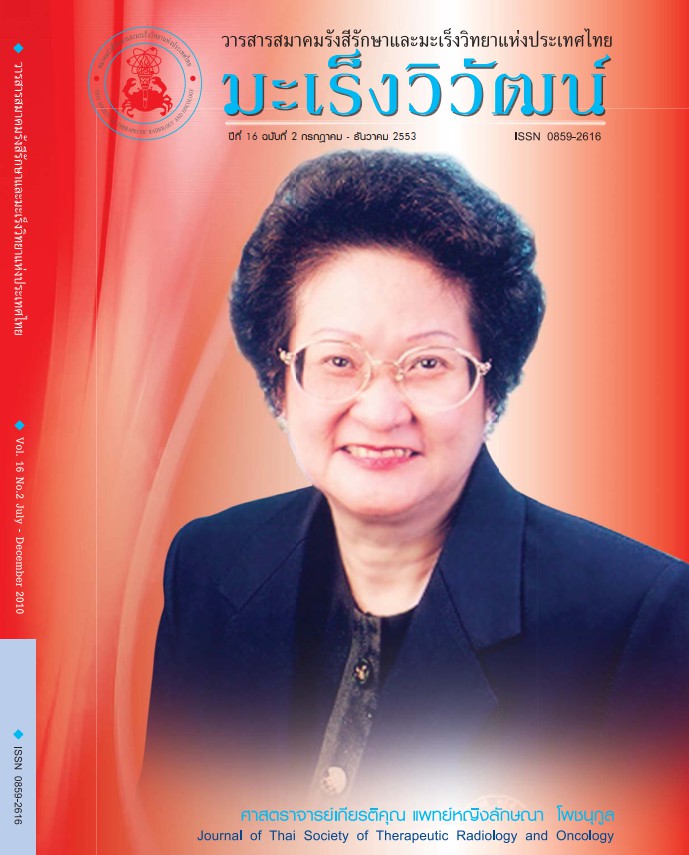The effect of contrast agents on dose calculation in conformal radiotherapy planning using computed tomography for tumors at different anatomical regions
Keywords:
Conformal radiotherapy, Contrast agent, Treatment planning, Dose calculationAbstract
The purpose of this study was to evaluate the effect of contrast agents on dose calculation in 3-Dimensional Conformal Radiotherapy (3D-CRT) for brain, thorax and upper abdomen region in Ramathibodi hospital. Five, six and four cancer patients for brain, thorax and upper abdomen region respectively were studied for retrospective study. Each patient took two sets of CT images in the same position before and after IV contrast agent injection. To avoid the movement artifact, the CT images of thorax and upper abdomen regions of without-contrast agent were imitated by overriding the density to the organs or regions using the density obtained from the original without-contrast agent CT images. The approved plan by a radiation oncologist was copied to both with- and without-contrast agent CT images. Both of the plans used the same monitor unit. The doses calculated from two plans were compared with regard to tumor volume and organs at risk volume. The paired sample t-test and gamma evaluation were used to evaluate the differences in dose distributions between two plans. The results of doses of tumor volume and organs at risk volume were not signifi cantly different between with - and without-contrast agent CT images for brain, thorax and upper abdomen region (p > 0.05), except heart organ in thorax region (p < 0.05) but the dose differences were less than 1% compared to dose calculated from without-contrast agent CT images. The number of passed pixel was more than 95% and the gamma value was less than 0.5 for dose distributions compared between two sets of CT images. As a result, using contrast agent at the time of CT simulation dose not signifi cantly affect on dose calculation in 3D-CRT.
References
Burridge NA, Rowbottom CG, Burt PA. Effect of contrast enhanced CT scans on heterogeneity corrected dose computations in the lung. J Appl Clin Med Phys 2006 Fall;7(4):1-12.
Choi Y, Kim JK, Lee HS, Hur WJ, Hong YS, Park S, et al. Infl uence of intravenous contrast agent on dose calculations of intensity modulated radiation therapy plans for head and neck cancer. Radiother Oncol 2006 Nov;81(2):158-62.
Letourneau D, Finlay M, O'Sullivan B, Waldron JN, Cummings BJ, Ringash J, et al. Lack of influence of intravenous contrast on head and neck IMRT dose distributions. Acta Oncol 2008;47(1):90-4.
Liauw SL, Amdur RJ, Mendenhall WM, Palta J, Kim S. The effect of intravenous contrast on intensity-modulated radiation therapy dose calculations for head and neck cancer. Am J Clin Oncol 2005 Oct;28(5):456-9.
Shibamoto Y, Naruse A, Fukuma H, Ayakawa S, Sugie C, Tomita N. Influence of contrast materials on dose calculation in radiotherapy planning using computed tomography for tumors at various anatomical regions: a prospective study. Radiother Oncol 2007 Jul;84(1):52-5.
Weber DC, Rouzaud M, Miralbell R. Bladder opacification does not significantly influence dose distribution inconformal radiotherapy of prostate cancer. Radiother Oncol 2001 Apr;59(1):95-7.
Nurushev T, Liu Q. Effect of Intravenous Contrast On Dose Distributions. Med Phys 2005;32(6):2032.
Venselaar J, Welleweerd H, Mijnheer B. Tolerances for the accuracy of photon beam dose calculations of treatment planning systems. Radiother Oncol 2001 Aug;60(2):191-201.
Agency IAEA. Commissioning and quality assurance of computerized planning systems for radiation treatment of cancer, Technical Report Series No.430. Vienna: IAEA; 2004.
Downloads
Published
How to Cite
Issue
Section
License
บทความที่ได้รับการตีพิมพ์เป็นลิขสิทธิ์ของวารสารมะเร็งวิวัฒน์ ข้อความที่ปรากฏในบทความแต่ละเรื่องในวารสารวิชาการเล่มนี้เป็นความคิดเห็นส่วนตัวของผู้เขียนแต่ละท่านไม่เกี่ยวข้องกับ และบุคคลากรท่านอื่น ๆ ใน สมาคมฯ แต่อย่างใด ความรับผิดชอบองค์ประกอบทั้งหมดของบทความแต่ละเรื่องเป็นของผู้เขียนแต่ละท่าน หากมีความผิดพลาดใดๆ ผู้เขียนแต่ละท่านจะรับผิดชอบบทความของตนเองแต่ผู้เดียว




